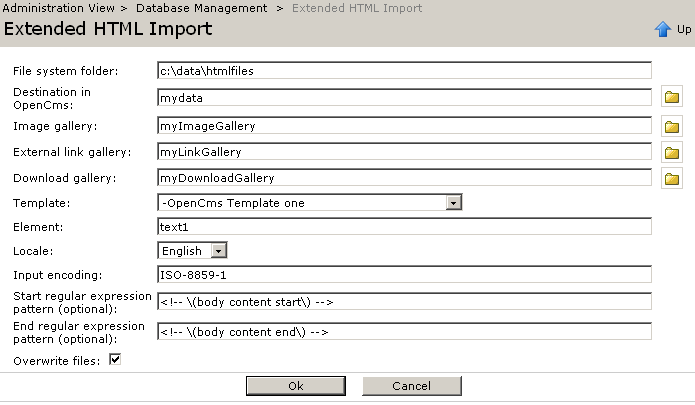User Guide
To use the "Extended HTML Import Module", the user must be logged in as an
Administrator. The HTML import dialog is shown by choosing the "Extended HTML Import" icon
in the OpenCms Backoffice.
- Log in as Administrator
- Change to the "Administration" view
- Change to the "Offline" project
- Click the "Database Management" icon
- Select the "Extended HTML Import" icon

An input dialog form is displayed where all required
import information has to be entered.

Explanation
- File System Folder
This is the folder in the local
file system where the files to be imported are stored. A full absolute path
must be entered here (e.g. C:\data\htmlfiles).
- Destination in OpenCms
The
destination in OpenCms to which the files are imported.
The path is to be seen
from the currently active site in the workplace. The destination folder must already exist
in OpenCms (e.g. /mydata/).
- Image Gallery:
The name of the image gallery in OpenCms (e.g. mypics). The gallery
must already exist in the /system/galleries/pics/ folder.
- External Link Gallery:
The name of the external link gallery in OpenCms (e.g.
mylinks). The gallery must already exist in the
/system/galleries/externallinks/ folder.
- Download Gallery:
The name of the download gallery in OpenCms (e.g. mygallery).
The gallery must already exist in the /system/galleries/download/ folder.
- Template: A
dropdown list with all available templates to use. The template selected here will be applied to
all imported HTML pages.
- Element: The
name of the content element of the template in OpenCms. The imported content will be stored in the specified element
in OpenCms.
- Locale: A dropdown list with all available Locales to
use. The content will be imported for the specified Locale.
- Input Encoding : This is the encoding
used in the imported files. (e.g. UTF-8). A correct encoding must be entered
here. If no encoding is entered, the encoding "ISO-8859-1" will be used. An
invalid encoding can result in errors or missing characters after the import
process, so the encoding must be chosen carefully.
- Start regular expression pattern for content extraction (optional):
This field defines the start regular
expression pattern for a content extraction during the import. Once a pattern
is defined, all HTML contents will be parsed for the specified start and
end pattern and extract the content between these patterns. You have to define
the end pattern, too.
- End Pattern for content extraction (optional):
This field defines
the end regular expression pattern for a content extraction during the
import.
- Overwrite files:
If checked, existing files in the
target folder and the gallery folders will be overwritten during the import
without further confirmation. Before checking this option, be sure that no important resources
are overwritten!
Note: Optionally you can create a "meta.properties"
file for each folder of your import structure. This property file
contains key/value pairs that set the OpenCms properties of the imported folder in
the "Virtual File System" (VFS) of OpenCms.
Example for a "meta.properties" file:
NavText=Folder
NavPos=1
myProperty=a comma \, separated \, value
Note: Use empty directories and
galleries for an import. If the import would lead to conflicting filenames, the
imported files will be renamed.
The import can be cancelled by clicking on the "Cancel" button of the
input form.
After clicking the "OK" button,
the directories, galleries, template and element entered in the input form
are validated. If one of them does not exist or is not valid, an error is
displayed and the input has to be corrected.

If the input was correct, the import starts and
displays a progress report on the screen.
The following steps are done during the import
process:
- Create an index of all files to be imported. In this
step, the new filenames and link targets inside OpenCms are calculated.
Links with no valid targets will not be modified.
- Import of all HTML files and folders, including
content conversion and link modifications of the HTML/XHTML content. This step
also collects the required information for steps 3 and 4, i.e. image
alternative texts and external references.
- Import of all other resources (images, downloads) to
the image and download galleries.
- Creation of all external links found during the
content parsing process.
When the import is completed, the report can be
reviewed. Click the "OK" Button to return to the administration
view.
|




